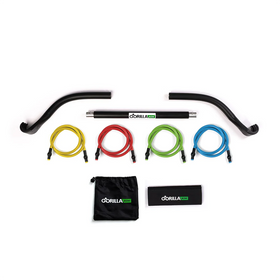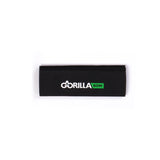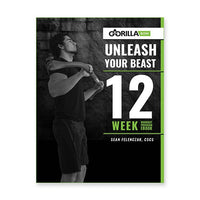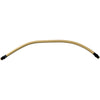These Top 5 Core Stretches Are the Best For Your Body

Take a look at any star athlete. What do you notice first? Maybe it’s their bulging biceps, their toned pecs, or maybe it’s their seriously defined calves. But let’s be real -- the first thing you’re looking at are their six-pack abs.
Getting toned abdominal muscles takes a bit more work than just doing crunches every now and then. It requires a combination of dynamic core exercises paired with a fat-burning diet. But you can’t bring the most important muscles to their limits if they’re too stiff to even move.
That’s where stretching comes into play. Stretching helps to enhance your flexibility by loosening your muscles. This gives you a broader range of motion and reduces the risk of injury/ soreness during and after your grind. Plus, core stretches just feel so, so good.
Lots of people know how to stretch their arms or legs before a workout, but the core often gets neglected. Let’s fix that by showing off our five favorite core stretches to help you turn that flat stomach into a chiseled masterpiece.
1. Cobra Pose
You’ll notice a common theme among a few of these stretches in that many of them are actually yoga poses. Yoga is a great exercise in general, but it’s especially good for the core since it focuses on finding your center of balance. Since your core is quite literally central to your whole body, these poses are highly effective at helping it flex.
The cobra pose will flex your rectus abdominis, which composes the area of the body we associate with six-packs. Having a strong rectus abdominis will not only let you look how you want, but it will also help support your back for better posture.
To do the cobra pose:
- Lie on your stomach with your hands on the floor below your shoulders. Keep your arms at your sides; elbows pointed up. Extend your legs so that your toes point back.
- Press your hips to the floor and lift your head and torso, arching your spine upward until you feel a gentle stretch in the abs. Don’t overextend your back; we just want a nice tug on the abdomen.
- Hold for about 15-30 seconds and then gently lower to the floor.
If you feel pain at any time during this pose (or any stretch), stop right away.
2. Child’s Pose
The child’s pose will help to stretch your lower back, which is just as much a part of your core as the abs on the front. By building a stronger back, you’ll have an easier time conducting exercises that require the contraction of your abs, like sit-ups or bicycle crunches.
To do the child’s pose:
- Sit on your knees with your ankles extended, and toes pointed back. Spread your knees a bit wider than your shoulders and lean forward to place your forehead on the floor.
- Push your hips back, moving your glutes towards your ankles. Extend your arms in front of your head, placing palms on the floor at shoulder width.
- Hold for 20 seconds or so. Slowly sit back up, one vertebra at a time.
3. Spinal Rotation
Your oblique muscles are another component of the core. These exist on the sides of your abdomen, and they help support your spine during movements where you bend from side to side.
The spinal rotation stretch is a dynamic stretch that loosens the muscles in your thoracic spine (upper back) while challenging the obliques. It can also help to lessen stiffness in your lower back.
To do a spinal rotation:
- Stand with your feet shoulder-width apart.
- With your arms extended straight out at your thighs, gently rotate your body to the left without moving your hips.
- Tighten your obliques and hold for five to ten seconds, and then switch to the other side. Repeat several times.
You can turn this into a full-fledged exercise by whipping out your Gorilla Bow. Place the bar on your shoulders and stand on the band to incorporate some much-needed resistance to strengthen those obliques instead of stretching them out.
4. Cat/Cow Pose
Just when you thought the yoga was done, we’ve got one more to throw your way. The cat/cow pose is really great for people who struggle with back pain because this movement activates each segment of the spine. Plus, it’s a dynamic stretch that can be a useful part of your warm-up.
Here’s how to do a cat/cow pose:
- Starting on your hands and knees, round your back and pull your belly button toward your spine. Tuck your chin towards your chest and allow your back to raise towards the ceiling, kind of like a cat.
- Slowly release one segment of your spine at a time until you arch your back in the opposite direction, jutting your abdomen toward the floor and lifting your chin up so that you’re looking straight ahead.
- Reverse the motion, slowly raising your back towards the ceiling again.
Like a real yoga master, it’s good to close your eyes during this move so you can heighten your ability to pinpoint any areas that feel extra stiff or uncomfortable.
5. Bridge
The final exercise in this list is the glute bridge. This engages your lower abdomen as well as your lower back, and it helps tremendously with core stability. This will help you be less shaky during planks or push-ups.
To do a bridge:
- Lie on the floor with your feet tucked close to your glutes, knees bent.
- Using your hips, raise your core towards the ceiling. Keep your spine straight, making a triangle shape with the floor.
- Hold this position for 20 to 30 seconds. Slowly release and lower yourself back to the floor.
You can turn this move into an exercise by putting a barbell on your hips or holding dumbbells in your hands and doing a close-grip decline chest press.
Importance of a Strong Core
The benefits of a strong core extend further than just humongous abs. As the name implies, your core is a central component, connecting your lower body and your upper body to one another. Almost every motion you make originates in your core.
Strong cores enhance your performance in sports or other activities. Pretty much every athletic activity, from golfing to kayaking, involves heavy utilization of your core. And if you can keep it nice and flexible, you might excel past most of the competition.
It can also help with balance and stability. A strong core stabilizes your spine, allowing you to make more complex movements without fear of falling. This lets you have a much broader access to a variety of exercises the next time you go to work out, but it also lets you be more agile on uneven terrain.
Since your core muscles support your spine, a strong core can improve your posture. Not only does this reduce the risk of back problems in the future, but it can also enhance your silhouette. Ever seen a body-builder who slouches? Probably not.
Having a strong core can also help with daily tasks like lifting heavy packages or turning around. This is especially important for older individuals who are hoping to regain some more functional independence.
How To Build Core Strength
Stretching your core is essential before any workout in general, let alone one devoted to your core. One of the great things about exercising your core is that there is a huge variety of different workouts that focus on it.
Building core strength definitely involves its fair share of stretching and strength training. However, it’s also essential that you incorporate fat-burning cardio and a healthy diet into your regimen. Having very little body fat is just as important for six-pack abs as doing a bunch of sit-ups.
Core Strength
Stretching your core can help improve your flexibility and decrease your risk of injury. Since your core is composed of a large number of different muscles, proper stretching must incorporate every single one.
The child’s pose and cat/cow pose help to strengthen and loosen your back, whereas the bridge and the cobra pose force your abdomen to put in some work. Spinal rotations give some attention to the obliques. If your warm-up consists of these five stretches, you’re off to a great start.
Be sure to supplement these stretches with proper strength training and cardio techniques for maximum results. If you want to achieve six-pack abs even faster, the Gorilla Bow All-Access Membership gives you access to live and on-demand classes that take your resistance training to the next level. From six-pack abs to bulging biceps, you’ll have your best body in no time.
Sources:
Static vs. Dynamic Stretching: What Are They and Which Should You Do? | Hospital for Special Surgery
The real-world benefits of strengthening your core | Harvard Health










Leave a comment